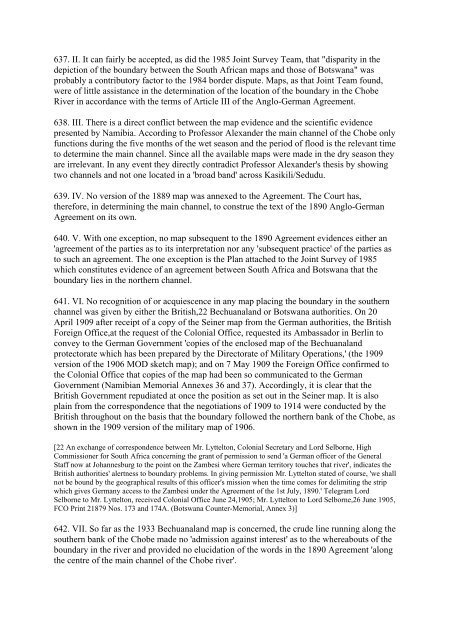botswana/namibia - Cour international de Justice
botswana/namibia - Cour international de Justice
botswana/namibia - Cour international de Justice
Create successful ePaper yourself
Turn your PDF publications into a flip-book with our unique Google optimized e-Paper software.
637. II. It can fairly be accepted, as did the 1985 Joint Survey Team, that "disparity in the<br />
<strong>de</strong>piction of the boundary between the South African maps and those of Botswana" was<br />
probably a contributory factor to the 1984 bor<strong>de</strong>r dispute. Maps, as that Joint Team found,<br />
were of little assistance in the <strong>de</strong>termination of the location of the boundary in the Chobe<br />
River in accordance with the terms of Article III of the Anglo-German Agreement.<br />
638. III. There is a direct conflict between the map evi<strong>de</strong>nce and the scientific evi<strong>de</strong>nce<br />
presented by Namibia. According to Professor Alexan<strong>de</strong>r the main channel of the Chobe only<br />
functions during the five months of the wet season and the period of flood is the relevant time<br />
to <strong>de</strong>termine the main channel. Since all the available maps were ma<strong>de</strong> in the dry season they<br />
are irrelevant. In any event they directly contradict Professor Alexan<strong>de</strong>r's thesis by showing<br />
two channels and not one located in a 'broad band' across Kasikili/Sedudu.<br />
639. IV. No version of the 1889 map was annexed to the Agreement. The <strong>Cour</strong>t has,<br />
therefore, in <strong>de</strong>termining the main channel, to construe the text of the 1890 Anglo-German<br />
Agreement on its own.<br />
640. V. With one exception, no map subsequent to the 1890 Agreement evi<strong>de</strong>nces either an<br />
'agreement of the parties as to its interpretation nor any 'subsequent practice' of the parties as<br />
to such an agreement. The one exception is the Plan attached to the Joint Survey of 1985<br />
which constitutes evi<strong>de</strong>nce of an agreement between South Africa and Botswana that the<br />
boundary lies in the northern channel.<br />
641. VI. No recognition of or acquiescence in any map placing the boundary in the southern<br />
channel was given by either the British,22 Bechuanaland or Botswana authorities. On 20<br />
April 1909 after receipt of a copy of the Seiner map from the German authorities, the British<br />
Foreign Office,at the request of the Colonial Office, requested its Ambassador in Berlin to<br />
convey to the German Government 'copies of the enclosed map of the Bechuanaland<br />
protectorate which has been prepared by the Directorate of Military Operations,' (the 1909<br />
version of the 1906 MOD sketch map); and on 7 May 1909 the Foreign Office confirmed to<br />
the Colonial Office that copies of the map had been so communicated to the German<br />
Government (Namibian Memorial Annexes 36 and 37). Accordingly, it is clear that the<br />
British Government repudiated at once the position as set out in the Seiner map. It is also<br />
plain from the correspon<strong>de</strong>nce that the negotiations of 1909 to 1914 were conducted by the<br />
British throughout on the basis that the boundary followed the northern bank of the Chobe, as<br />
shown in the 1909 version of the military map of 1906.<br />
[22 An exchange of correspon<strong>de</strong>nce between Mr. Lyttelton, Colonial Secretary and Lord Selborne, High<br />
Commissioner for South Africa concerning the grant of permission to send 'a German officer of the General<br />
Staff now at Johannesburg to the point on the Zambesi where German territory touches that river', indicates the<br />
British authorities' alertness to boundary problems. In giving permission Mr. Lyttelton stated of course, 'we shall<br />
not be bound by the geographical results of this officer's mission when the time comes for <strong>de</strong>limiting the strip<br />
which gives Germany access to the Zambesi un<strong>de</strong>r the Agreement of the 1st July, 1890.' Telegram Lord<br />
Selborne to Mr. Lyttelton, received Colonial Office June 24,1905; Mr. Lyttelton to Lord Selborne,26 June 1905,<br />
FCO Print 21879 Nos. 173 and 174A. (Botswana Counter-Memorial, Annex 3)]<br />
642. VII. So far as the 1933 Bechuanaland map is concerned, the cru<strong>de</strong> line running along the<br />
southern bank of the Chobe ma<strong>de</strong> no 'admission against interest' as to the whereabouts of the<br />
boundary in the river and provi<strong>de</strong>d no elucidation of the words in the 1890 Agreement 'along<br />
the centre of the main channel of the Chobe river'.

















